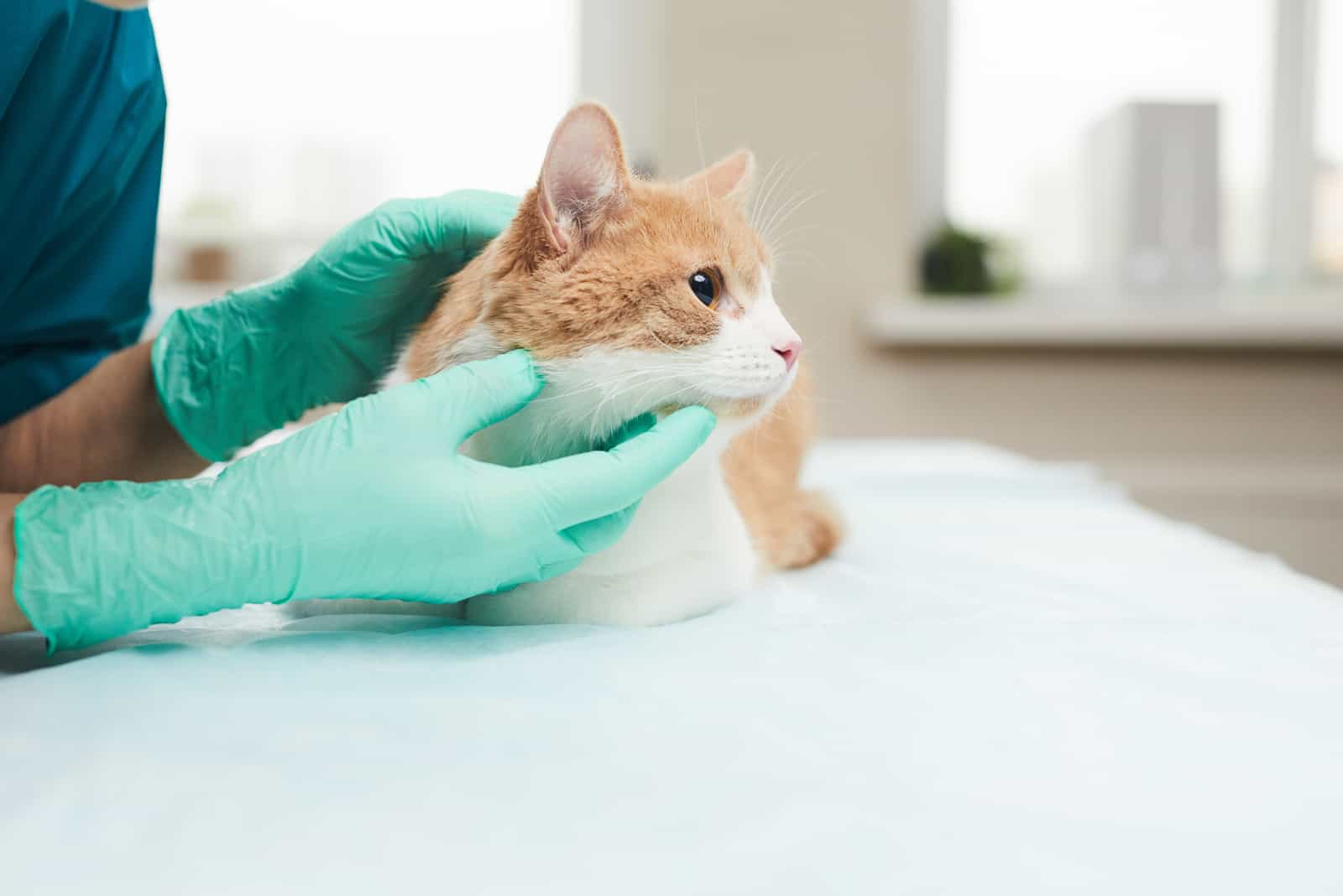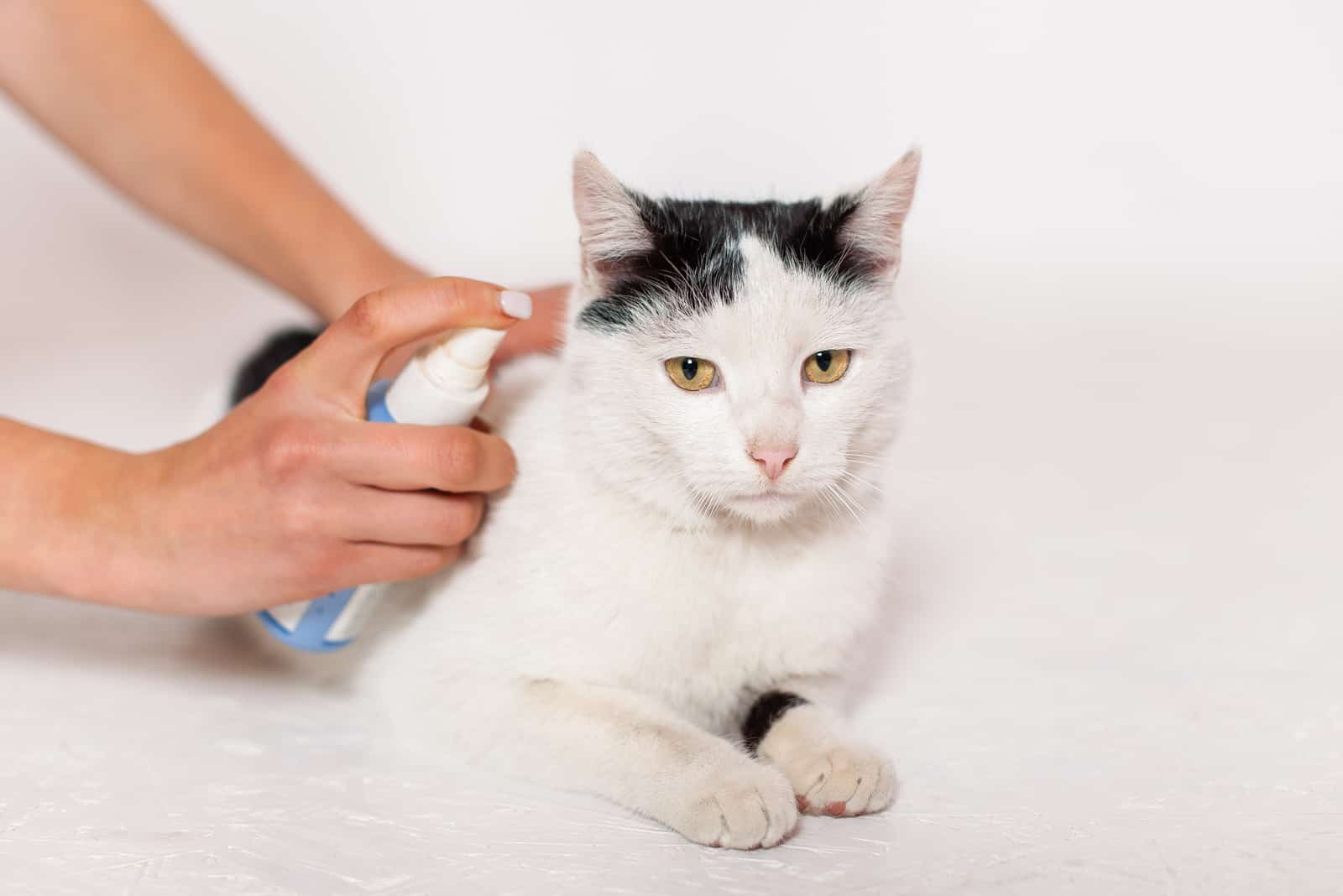Should You Pick Scabs Off Cats? Best Explanation

We always want the best for our cat’s health, which is why we get concerned when we notice something unusual about them.
Cats are beautiful, majestic creatures. While some breeds may be more elegant than others, all cat breeds have lovable attributes.
Some cats like to scratch more than they like to groom and if there is any kind of skin issue, they will scratch even more.
If your cat is feisty and gets into fights with other cats, scratches can easily turn into abscesses, and scabs are common. These are all normal things, and luckily there is a solution to every problem.
When you notice a scab through your pet’s fur, or any kind of lesion on their skin, you may well get worried. It is not a pretty sight, and it is definitely not good for their health.
A scab can be a mild irritant or a dangerous health issue. But should you pick scabs off cats? Read on and find out.
Should You Pick Scabs Off Cats? Or Leave Them Be?

So, should you pick scabs off your cat or leave them be? Either way, your cat will probably scratch them itself.
Some people cannot resist the urge to pick scabs, so it is a good thing you’re reading this because, in fact, you should never pick your cat’s scabs.
Picking at a scab can only make it worse. Scabs are formed after open wounds, scratches, or skin irritations occur; scabs protect the skin while it heals.
Your cat might scratch themselves too hard, or injure some part of their body while exploring around, and just like with people, scabs form.
If you fall or scratch your arm for example, a scab will form to stop the bleeding and protect the skin while it is healing.
There are, however, different reasons why cats get scabs, and some are more serious than others.
There are different ways to treat scabs and it is important to know which remedies to use. All of this is explained below.
4 Most Common Causes Of Scabs In Cats
Aside from injury, the most common reasons for cat scabs include allergies, infections, parasites, dermatitis and dry skin, as well as your cat’s diet; which can be both the problem and the solution.
1. Dry Skin

Your cat can simply have very dry skin so scabs form easily, which then irritates them even more.
When a cat has dry skin, similarly to people, it gets itchy. This is why your cat might scratch themselves even more than usual and make scabs more likely to form.
Dry cat’s skin is usually caused because of too much sun, stress, usage of wrong shampoo, not enough moisture in the air, or low water intake which can cause dehydration.
When winter comes and you start using heaters, this can cause dry air and when there is not enough moisture, your indoor cat can get dry skin. You can get an air humidifier to remedy dry air
Use moisturizing lotions which are safe for your cat, such as coconut oil, and make sure your cat’s shampoo is appropriate for their skin condition.
Make sure your cat drinks enough water, and you will reduce the risk of crusty scabs.
2. Allergy
Cat allergies or bacterial infections are one of the most common causes of scabs. Cats can suffer from several different allergies.
If your cat has developed some kind of allergy, you will notice they are constantly scratching, breathing differently, sneezing, diarrhea or vomiting, and of course scabs caused by too much scratching.
– Food Allergy
Cats are quite prone to developing a food allergy.
If you suspect that your cat has an allergy to a particular food, you should change their diet and try to identify which type of cat food they’re allergic to.
– Environmental Allergy
Your cat can also be allergic to certain plants, or even grass. If you think that your cat could be allergic to a certain environment, try to keep them inside for a while to see if their health improves.
You can contact the vet of course, if you want them to run an allergy test right away.
– Allergy To Insects
Cats, just like humans, can be allergic to insects, such as bugs, bees, spiders, etc.
And just like us, if bugs bite or sting us, we may have an allergic reaction. These can be mild or highly dangerous.
Cats, like dogs, like to chase bugs and insects around, which is harmless but you should be cautious if your cat’s behavior changes after they’ve been outdoors or played with insects.
Going to the vet is always a good idea if you suspect your pet has been bitten or stung.
– Allergy To Fabric Or Plastic
Cats can have an allergy to some fabrics or plastic. Toys or bowls are usually made out of plastic, you can switch bowls to ceramic and toys for woolen or spongy ones.
Your cat can have an allergic reaction to new furniture or fabrics with a new smell, since they are curious and like to check everything out.
Some new scents or materials can contain allergens, so if you notice some skin problems in your cat after you’ve brought home a new pillow for example, you should kiss it goodbye.
Kiss what goodbye? The pillow of course!
3. Miliary Dermatitis

Feline miliary dermatitis, feline acne, or eczema as it is sometimes called, can also be a common cause of the scabs.
Once miliary dermatitis is present, you may see lesions on your cat’s skin, and this will look like a crusty skin infection.
Miliary dermatitis in cats is most usually caused by FAD, also known as flea allergy dermatitis.
Scabs do not form right away; first your cat feels extremely itchy, then they scratch themselves. The more they scratch, the more danger of developing a scab.
This can lead to more problems such as bacterial infections, because when your cat scratches or bites at a scab, they continually open the wound beneath the scab.
Various bacteria live on your cat’s fur; they are harmless unless they enter their skin. This happens when your cat scratches its scabs and opens the door for bacteria.
If you treat flea infestations regularly, you can prevent bigger issues like this from happening.
4. Parasites
There are many parasites that your cat can pick up. The parasites which commonly cause scabs are ringworms, mites, fleas, and ticks.
– Ringworms
Ringworms are the most common parasitic skin infection in cats. This is a fungal infection, which is recognizable by areas of hair loss and crusty skin on the affected areas.
These will usually appear on a cat’s tail, paws, head, or tips of the ears. Cats will scratch these scabs and then crusts will form over them.
Your vet will probably prescribe some antihistamines and antibiotics, and some antifungal creams or ointments.
Once the damaged areas – which will be bald, but healthy – stop being red and itchy, you will know your cat is healing.
– Mites
Some people think mites are the same as fleas, but this is not true. Mites inhabit only the cat’s ears, because they eat ear wax. Sometimes they are called ear mites.
They can, however, spread around and this can cause a different skin disease called mange.
Mange is a disease that makes your cat’s skin go dry. Spots of dry skin occur, and make your cat scratch itself more than usual.
This needs to be treated before your cat tears its skin off from scratching.
Scabs are formed, but the skin is also still itchy, so your cat keeps scratching, picking the scabs off.
Your vet will give you advice on how to treat mange. If you regularly use anti-flea products on your cat, this will serve as prevention for mites too.
– Fleas
Most cats have fleas at some point, especially if they go outdoors. This is a common problem that many cat owners deal with.
I adopted a stray cat and was really freaked out when I found out that outdoor cats almost always have fleas, even if you can’t see them.
You can prevent fleas from infesting your lovely pet, and keep them away, by using anti-flea treatments.
You should always treat your cat for fleas, but also take precautions when choosing the remedy for it. Your cat’s immune system might not be strong enough for certain types of flea treatment.
Both outdoor and indoor cats can get fleas. It is more common in outdoor cats but it doesn’t matter if your cat doesn’t go outside or play with other cats as it can stick to our clothes or shoes, and without knowing we can bring them into the house and infect our cats.
Allergies from fleas? Cats are not allergic to fleas but to their bite, just as it is with other insects.
Cats can have an allergic reaction from flea saliva if a flea bites them. It will cause itchiness, and your cat will scratch like crazy.
This is called flea allergy dermatitis (FAD), and is more common in dogs than cats.
– Ticks
Ticks are dangerous for humans, dogs, and cats. Cats will not scratch themselves because ticks do not move around and don’t feel itchy.
They just stick to your cat’s skin and suck their blood. Vampire parasites, am I right?
Ticks can transfer various diseases, because they feed on the blood of different creatures, and may become infected by their diseases through their blood.
If you notice a tick on your cat, you need to safely take it out.
You need to put gloves on and pull the tick out using tweezers. You need to be very careful when doing this, because you want to make sure you take the whole tick out.
You need to pull out the whole tick; if you twist or turn with the tweezers you will only remove the head and the teeth will stay attached to your cat’s body.
If you are not sure about tick removal, it’s best to go to the vet. While for the experienced, tick removal is a job completed within seconds, it’s always best to be safe right?
Once you do get the tick out, you should drown it in alcohol. After it has been removed, a scab will appear where the tick bit your cat.
Treatments & Remedies

We’ve discussed some treatment methods above while talking about the most common reasons scabs appear.
Once you’ve seen and excluded the possible causes, there are a few more ways to treat your cat’s skin.
Here are some more topical treatments and at home remedies to get rid of scabs as quickly as possible.
– Topical Creams Or Sprays
Topical steroid creams and sprays are commonly used for treating scabs. They help your cat to feel less itchy, and cure their inflamed skin.
You will find that after you rub the cream on their skin, they will not scratch as much as they used to.
This is an easy and effective treatment you can do at home, but you should talk to your vet before using any cream or medication.
Your vet will prescribe it to you or you can get it over the counter.
– Bandage & Cone
Once you start treating scab wounds, you can wrap a warm cloth or a towel around your cat’s inflamed areas.
This will soothe their pain and also prevent them from scratching the area.
You can also go to the vet and see if they can wrap some gauze around, especially if you’re not sure how to do it properly.
If your cat is still itchy, and you cannot prevent them from scratching, biting and picking their scabs off, you can consult your vet about using a cone.
A cone is put around your cat’s neck,to ensure they are unable to scratch their head area (if scabs are present there) and they cannot bite their body area.
– Natural Treatments
Besides the treatments and remedies mentioned above, there are also some natural treatments you can try at home.
Always make sure they are safe and pet-friendly. The treatments listed below are safe for your cat.
Coconut Oil
Coconut oil has antibacterial properties. It helps strengthen your cat’s immune system, and it is anti-inflammatory.
When you use coconut oil as a cream, it can do wonders. It is good for us, but also for our cats.
Coconut oil hydrates the cat’s skin and fur, and it may also be a useful addition to the cat’s diet as it helps them digest food more easily.
Epsom Salt
Epsom salts are great to use when bathing your cat. They are not expensive and they may help to calm your cat’s irritated skin.
Warm water helps, and when you add healing salt it is even better. Salts will reduce the swelling too so you can easily clean the inflamed areas.
If your cat is not allergic to bathing salts, this is a great solution for you.
Oatmeal
I know what you’re thinking: “salt, oil, oatmeal, what kind of recipe is this?” lol
Don’t worry, this is not a recipe, these are just inexpensive at-home treatments. As for oatmeal, you can add it to warm bathing water and let your cat have its own spa day.
This is a great way to deal with itchy skin and to prevent your cat from picking off their scabs.
Again, this is a good solution for cats who do not hate water and bathing.
Oatmeal is safe for your cat, so it is also fine if they lick themselves after the bath.
Calendula
Calendula also has anti-inflammatory properties. It can be used as a spray to ease your cat’s itchy skin.
You can also soak a towel or a cloth in water infused with calendula flowers and apply it on your cat’s affected areas, if your cat will tolerate it.
This remedy, however, can contain some toxic acids, so be sure to rinse it off before letting your cat groom itself.
Final Words
To conclude, should you pick scabs off cats? No!
It is definitely not a good idea to pick any scab. Picking your cat’s scabs will only disrupt the healing process. Remember that scabs form to protect the skin while it is healing.
There are various reasons why scabs appear, such as parasites, dry skin, infections, or dermatitis. There are also various solutions for each of these causes.
Scabs are not dangerous, however it is crucial to know about them and their treatment so they don’t become a more serious issue.. Everything can be solved once you find the cause of the issue and treat it effectively.
As pet owners, we want only the best for our furry friend’s health, so always be sure to talk to your vet because they are there to help.






